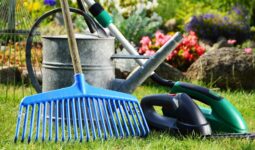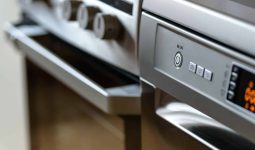We all regularly use different types of spatulas. Whether for cooking, baking, or grilling, we can no longer do without this accessory in our kitchen drawer.
A quick refresher on the origins of the different types of spatula: The word “spatula” has a history as varied as its present-day usage—literally.
It dates back to the Roman Empire and comes from the Latin word spathe, which refers to a broad-bladed sword.
It first appeared in English in 1525, and from a weapon, it became an accessory that is more often used in apothecaries.
Today, it describes any kitchen tool with a long handle and a thin, flexible blade.
You probably don’t spend too much time thinking about spatulas, but you’ve probably used one of these wonderful gadgets integral to kitchens worldwide.
Spatulas were originally all-purpose kitchen utensils, but they slowly became specialized, like everything from spoons to forks and bowls in the modern kitchen.
There are now different types of spatulas in the market made of different materials you use to cook various things.
There are much more differences here than just their aesthetics. It’s possible to be very versatile with your cookware in your kitchen, but you don’t want to wait until you’re trying to cook a special meal for a crowd to figure out how to use each one best.
We’ll cover 12 different spatulas you might have in your home, along with the pros and cons of each type of material, to help you choose and buy the right type of spatula for cooking every meal.
How the Different Types of Spatula Are Categorized
As we have established, spatulas fall into three main categories: flippers, spreaders, and scrapers. Each has its specific purpose and comes in a variety of options and features.
Flippers (aka Turners)
This spatula has a long handle and a wide, thin surface that is generally trapezoidal. It can be solid or slotted, and the “blade” is about the size of a human hand.
The tip is often tapered to facilitate sliding under food. It is used to flip foods such as grilled cheese, fried eggs, hamburger patties, chopped vegetables, etc.
Spreaders
This is a different type of spatula that comes with a long, narrow blade. Most spreader-type spatulas are made of metal, such as stainless steel, although many plastic and rubber models exist.
They are best used for spreading soft fillings such as cake frosting, cheese spreads, and sandwich condiments.
The rounded end is ideal for scooping the perfect amount of creamy filling, and the flexible blade makes it easy to spread the filling without tearing bread or pie crust.
Scrapers
It is hard to describe but easy to recognize: a rubber-tipped scraper with a rectangular head and at least one rounded edge placed on the end of a straight handle.
They come in a variety of widths and lengths and in a range of bright colors that make them more fun than the average kitchenware.
Cold, wet ingredients in a mixing bowl are ideal for mixing, folding, scraping, etc. No tool better cleans sticky dough off a flat surface than a baker’s scraper spatula.
Different Types of Spatulas
1. Fish Spatula
One of the most popular spatulas is the fish spatula, also included in the slotted spatulas.
It is one of the most important kitchen accessories you can have on hand. A fish spatula is a metal spatula that can turn fish and meat.
The spatula has a rigid, strong, flexible, and thin blade. The sharp edges and beveled head are useful for flipping in tricky situations.
They usually have a metal or stainless steel design to make them more durable. They are also larger in shape with slotted holes, making them ideal for flipping fish fillets or pancakes and draining liquid or oil from food before placing it on a plate.
2. Perforated Flipper Spatula
Sometimes called turners, this type of spatula has a long handle and a thin, wide trapezoidal surface to hold food.
This surface can be called the blade and usually has small holes that allow excess oil to drain.
The purpose of this spatula is to turn things over in a hot pan. Because of this use, many are made of metal, which allows for a thinner blade that can slip under food without damaging it.
Due to their design and construction, perforated spatulas are ideal for flipping burgers.
3. Slotted Spatula
Slotted spatula types have the same characteristics and shape as perforated spatula.
However, they usually have slots running along the length of the blade rather than a series of holes, with each slot being about ¼ inch wide.
All holes are generally larger than those in a perforated spatula. These spatulas have slots to help the blade slide under food without breaking it.
This makes it a great option for making meatballs, crepes, or any other food that needs to remain shaped.
This type of spatula can be used to slice food, flip food, and filter substances or food by keeping the solid part on the blade and releasing the liquid through the slots.
The flipper, turner, and fish spatula are part of the slotted spatula family.
4. Solid Spatula
A variation of the slotted spatula, the solid spatula comes with no holes or slots, making it ideal for flipping pancakes and eggs.
Like the Slotted Spatula, the Solid Spatula is available in various materials, including Teflon, stainless steel, and wood.
5. Grill Spatula
The grill spatulas are some of the most durable and are designed to withstand the harshness of direct contact with embers and the outdoors.
This different spatula type is similar to a flipping one but has no holes or slots in the design.
Instead, you’ll get an ultra-smooth blade that won’t catch chunks of meat or whatever you’re cooking inside.
Some models may also have a bent handle, which will help keep your hand about an inch from the hot surface.
This spatula is common for turning and transferring food from the grill to the plate.
On the other hand, heavier metal spatulas work well as a smasher, pressing down on a piece of meat while cooking to ensure it’s done.
6. BBQ Spatula
As the name implies, this spatula type is widely used for grilling. It has a slotted design with holes that allow liquids and oils to flow through.
It is also made of materials that can withstand enough heat due to its use.
However, you don’t have to limit the use of this spatula to grilling. You can easily use it for flipping burgers, flipping steaks, or sautéing vegetables.
7. Giant Spatula
A giant spatula is another type of flipping spatula, ideal for flipping large items like cakes and pizzas. It is usually metal and has the same characteristics as a fish spatula.
Even though sometimes the giant spatula has no metal construction, it will still be made of heat-resistant material.
8. Flat Frosting Spatula
A flat frosting spatula has a blade that sticks out of the handle. Sometimes, the blade is in line with the handle without moving or bending.
A flat frosting spatula, also known as a palette knife, is a type of spatula specially designed to apply substances to flat surfaces, including cake icing.
If you are hosting a sandwich party for guests, this spatula is ideal for fluffing the sandwiches.
It comes in a very thin form that looks like a knife with a rounded tip, and you can also use it to cut cakes.
9. Offset Spatula
In short, an offset spatula is a narrower and more extended version of a spreading spatula.
They come with a bend just in front of the handle, allowing you to cover a larger area without straining your wrists.
An offset spatula is an essential baking tool. The blade of this knife is usually bent under the handle by half an inch. Thanks to this shape, it is easy to handle and manipulate.
You can apply frosting or icing to intricate parts and areas of your cake. With this spatula, your fingers won’t get in the way when applying the frost.
You can use an offset spatula for more than frosting cakes, like spreading the cookie dough evenly.
You may also use this spatula to loosen the edges of cakes when they come out of the oven.
This spatula is usually silicone or metal and is rarely available in plastic.
However, they are rarer because they have a narrow range of action, so it is not uncommon for professional bakers to buy only these spatulas.
10. Multi-purpose Or Silicone Spatula
In terms of quality, these spatulas are slightly better than rubber ones.
They are an excellent alternative to a metal spatula if you use them with non-stick pans and dishes.
The silicone spatula is very heat resistant and can be used for cooking, mixing, and baking. It can also be used with other traditional utensils.
If you like to bake, this spatula will be useful for sticky bread dough. It can also make soups and stews, so nothing sticks to your pan.
There is a smaller variant of this spatula that you can use to remove peanut butter from the jar. Since it is heat resistant, you can also use it for sautéing.
Silicone is available in almost all spatula designs but is very popular in baking or sweet-making.
It tends to retain stronger odors, so if you’re dealing with intensely flavored foods like fried onions, you can easily transfer the flavor to the spatula material.
11. Scrapers Or Rubber Spatula
Scrapers are similar to silicone spatulas but are rigid and made of plastic or rubber.
This spatula is one of the most widely used and affordable options. However, it should not be used on hot surfaces, as it will melt.
They are also available in many colors, which makes them fun compared to other accessories.
You loved to play with these spatulas as a kid while helping your parents in the kitchen.
They typically have a very rough rectangular blade with rounded edges, and this rounded edge is on one of the two sides of the blade. You can also find them at different lengths and widths.
While this spatula works well for scraping cookie dough from the bottom of a bowl, it can also be used as a flipper and serving dish from the cooking pan.
This spatula should allow you to reach the edges of the bowls and mix ingredients.
Scraping paddles tend to be thicker, so they can damage more delicate foods if you’re not careful.
12. Half Spatula
A half spatula is a rubber spatula with a blade about half the size of a normal spatula.
Due to its size, it has many uses. First, half a spatula can be used to scoop the jam out of the small jars, and it can also be used for mixing while cooking.
Materials Used for the Different Types of Spatula
Different types of spatula are made from different materials, and each material has its pros and cons.
The most common materials used to make spatulas are stainless steel, wood, plastic, silicone, and Teflon. Let’s examine how each material is made.
1. Stainless Steel
As the name suggests, stainless steel materials are made of stainless steel based on their construction.
Stainless steel blades are the strongest of the different spatula types and are more durable.
They can easily withstand contact with very high temperatures, making them good material for grilling or flipping.
Additionally, these spatulas can be molded into a very thin shape, making it easier to handle crumbly items.
However, whichever model you choose, it should come with a thicker wooden handle to make it safer. Metal can go from barely warm to red hot very quickly, but the wood does not heat up.
Stainless steel spatulas can scratch your non-stick pots and pans if you’re not careful. In addition, they are also not suitable for use in enamel pans and cast iron pans.
2. Wooden Spatulas
Another material often used in spatulas is wood. Both are environmentally friendly and economical.
Unlike stainless steel spatulas, wooden or bamboo spatulas are popular for preserving non-stick cast iron pots and pans. They also have a comfortable grip that won’t get hot or burn your hand.
If properly cared for, this spatula can last for decades. Wash it immediately after use and dry it completely.
However, wooden spatulas often do not have sharp edges and, therefore, cannot be used for flipping. Additionally, since wood is a porous organic material, it provides a comfortable environment for bacteria to grow.
However, you should be able to get rid of it by washing it well after each use. You should also avoid using this type of spatula when handling raw meat.
3. Plastic Spatulas
Plastic spatulas are an economical alternative to wooden spatulas. They’re usually very easy to find and cheap to buy.
Almost every type of spatula on the market has a plastic version, an excellent option for setting up your kitchen on a budget.
They are easy to clean and withstand heavy washes, dishwashers, and accidental drops.
However, they can leach chemicals into food, and if you ever put a plastic spatula on a hot pan and leave it on, it will melt and lose shape.
So, while plastic spatulas can make great scrapers for scraping bowls while baking or mixing, they are not advised for cooking.
4. Silicone Spatulas
Silicone is probably the most common material used to make spatulas.
Like stainless steel and wooden spatulas, silicone spatulas are heat resistant. Plus, they won’t scratch non-stick or enamel pans and pots.
These qualities make this type of spatula a good choice for frosting and baking projects; however, before buying a silicone spatula for your kitchen, ensure you know its heat resistance range.
5. Teflon Spatulas
Another material used in the production of spatulas is Teflon. It is also an ideal option for non-stick pots and pans; however, just like silicone spatulas, you should be aware of the heat resistance range of your Teflon spatulas.
Conclusion
A spatula is an essential kitchen tool whether you stir-fry, bake, or cook food. Now that you know what qualifies as a spatula, you’re better positioned to decide which is right for you. So what are you waiting for?








